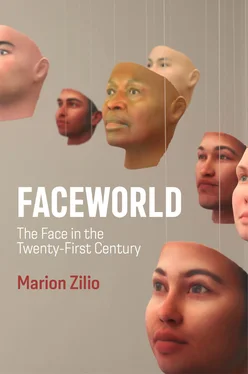#NuggsForCarter overtook Degeneres’s selfie – or should we say usfie – of a gaggle of stars, in which she appeared alongside Bradley Cooper, Meryl Streep, Julia Roberts, Brad Pitt, Angelina Jolie, Lupita Nyong’o, and Jennifer Lawrence. But what had seemed like a spontaneous whim on the part of the Oscars host was actually an impressive marketing coup orchestrated by Samsung – the evening’s sponsor – to promote its Galaxy Note 3 smartphone. Making the stars into unwitting brand ambassadors, the South Korean manufacturer’s VIP marketing strategy had converted their faces into exchange value, potentially revealing something more than just their own ‘visibility capital’. Not that there was anything new in itself about the idea of using icons’ faces as a sales pitch. Neither was there anything extraordinary, in a digital culture, about images being circulated, shared, and manipulated in all sorts of ways. And yet this act did herald a new turn, functioning as a kind of decisive punctum that would drive contemporary research on the selfie and determine its orientation.
The historic photo was taken on 2 March 2014 – just a few months before the word ‘selfie’ was officially added to the Oxford English Dictionary . Even though online self-portraiture had been silently proliferating for years, and even though various social networks revolved around images of users’ faces, suddenly everyone was rushing to register their take on this new object. Who would denounce the narcissistic tendencies and egotistical neurosis of the individual? Who would see it as a vast database capable of producing a sociology of the contemporary ethos, as in Lev Manovich’s SelfieCity project? 1Who would accuse it of being a profiling tool designed for advertisers or an aspect of the ‘Facebookization’ of the world? And finally, who would see this new face as a conversational object, 2no longer the preserve of an oversized ego but open to others and to the world, in accordance with a relational logic typical of the so-called ‘Web 2.0’ era? Treated as pure data, quantifiable and analysable by way of a host of diagrams, curves, and algorithms, the face had become an insubstantial reflection of the contemporary aspirations courted by the industries of singularity.
But all that these proliferating discourses were really saying was that the portrait and the self-portrait genre no longer made much sense. The face was now operating in terms of avatars, profiles, traces, and indexes, apparently following a path opened up by the nineteenth century: that of a calculative reason, a limitless ratio that stripped the face of all its enigmatic qualities, converting it into a cipher only so as to decipher it with ever greater precision. Yet few commentators sought to trace these practices back to the processes that had originally generated them. And few paid any attention at all to a shift in terminology that had taken place unnoticed: no longer unique and private ‘portraits’, commemorative souvenirs of our forebears, but ‘faces’ – faces which had now become images, flows, commodities, screens for all kinds of phantasmatic, economic, and technical projections.
In response to this shift, during the twentieth century, art – which of course had been responsible for the first portraits – had instigated a programme of ‘defacialization’. Everywhere faces were devoured, masked, erased, and reified. Artists sought progressively to obliterate the categories of the ‘subject’, the ‘self’, and the ‘I’; in other words, the category of identity in its most immutable, substantial, and metaphysical forms. This led to the creation of faceless faces, faces that were pure exteriority without interiority. No doubt the atrocities of war had left their black mark on the history of the contemporary face, as the themes of the ugly and the formless went hand in hand with the century of great wars. But the fact that the humanity of man could not survive the horror of the Shoah, and that this epiphany had brought him into conflict with his own stereotype, could actually be traced back to more complex antecedents. For the slippage from portrait to face and subsequently to the non-face actually responded to another crisis: the paradoxical crisis of the invention of the face.
This paradox is internal and unselfconscious: rooted in the most decisive features of the face, it operates in utmost secrecy. Whence this discrepancy: never in human history has the face been so widely represented and so firmly established; but at the same time, never has it seemed so threatened by emptiness and extinction. Affected by this obscure rift, the face seems at odds with itself; it seems to be consuming itself from within. Today the face may run a daily gauntlet of mirrors and multiple images of itself, it may circulate through networks and be shared by interconnected devices – indeed, all of this may have become more commonplace than ever before. But anyone who interrogates the origins of the face, and more precisely the possibility of individuals observing themselves, cannot deny that with the invention of the face, what we are dealing with is an event in the history of humanity that is relatively recent and, to say the very least, singular.
Chronicle of a Death Foretold?
With the Facebookization of the world, we have become so used to holding a book of faces in the palm of our hand that we no longer have any sense of the uneasiness of our ancestors, less than a century and a half ago, when for the first time they were able to pick up and hold their own externalized faces. Over a very short period, anyone and everyone would find themselves in possession of their face, materialized in an external medium. Thanks to photography, a portrait could be stored in a jacket pocket, passed from hand to hand, and transmitted from generation to generation. This democratization would be accompanied by an increasing uniformity and banalization of the face, to the point where some portraits could be switched in photographers’ studios without the customer even noticing. The mass production and standardization of ‘portraitomania’ was accompanied by something close to a misrecognition of one’s own face.
Although even today it is the lot of any person with restricted visual access to their face – limited to the traditional photographs of school classes, birthdays, and other such events – this deficiency in recognition has for the most part been superseded by a sort of hypermnesia: an infinite memory of self-images, where memory no longer designates the remembrance of the past or the outcome of a long-term crystallization, but instead a flashback, often to an anodyne moment, part of an everyday life constructed and broadcast in real time. Today the face of a foetus may be posted online even before birth. Plastic surgery can mould a face on demand, and science has made it possible to transplant a face – soon it will be a head – onto another body. Saudi Arabia has just granted citizenship to a silicon face supposedly inhabited by an artificial intelligence, and the latest iPhone has made the face into a password. Who knows, in the near future we may file patents to assert our right to the uniqueness of our own face. We will no longer worry about surveillance cameras, but about applications that steal identities by manipulating expressions – like Face Swap Live, which allows Snapchat users to try on different faces in real time. By exchanging their own face directly and automatically with another, or with something else, this app allows its users to take on the features of an animal, an older person, someone of the opposite sex, a film star mask, or even a bicycle wheel. It’s a feature that certainly lends itself to comic antics, but it is not difficult to imagine how it could be misused for criminal purposes. The promises of such effects are already tantalizing Hollywood studios quite prepared to spend millions of dollars on bringing back dead actors or rejuvenating ageing stars. We have begun to see the first attempts, in Fast and Furious 7 and Star Wars: The Force Awakens , and in experiments by the research team who were able to make Vladimir Putin smile and Donald Trump say whatever they wanted him to. Since the face is exteriorized from the very outset, it is no doubt this potential for faces to be stored, modelled, and infinitely manipulated that explains digital natives’ preference for applications that feature a pseudo-ephemeral temporality, where images are not captured but continually vanish into oblivion.
Читать дальше












